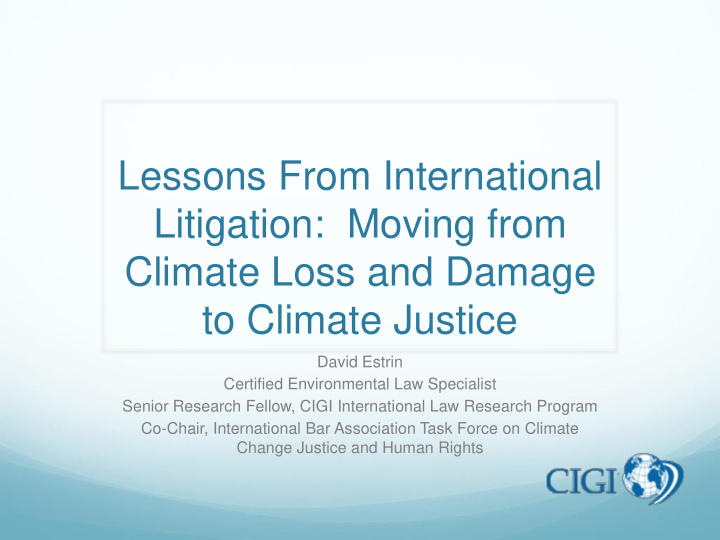



Lessons From International Litigation: Moving from Climate Loss and Damage to Climate Justice David Estrin Certified Environmental Law Specialist Senior Research Fellow, CIGI International Law Research Program Co-Chair, International Bar Association Task Force on Climate Change Justice and Human Rights
Achieving climate justice and human rights in addressing climate change
The CO 2 reduction imperative “There is also no certainty that adaptation to a 4°C world is possible. A 4°C world is likely to be one in which communities, cities and countries would experience severe disruptions, damage, and dislocation, with many of these risks spread unequally. It is likely that the poor will suffer most and the global community could become more fractured, and unequal than today. ” World Bank and the Potsdam Institute, 2012 6
The carbon budget Carbon budget cumulative emissions targets Cap emissions below one trillion tonnes (or below a concentration of 450 ppm) to avoid 2°C warming scenario (IPCC, Meinshausen et al) A cap of 600 billion tonnes would be necessary to more securely safeguard the climate system for future generations (Hansen & the Columbia Earth Institute) 7
As of June 2014 As of June 2014 580.7 billion tonnes of CO2 have already been emitted At current rates the trillionth tonne would be emitted in December 2040 trillionthtonne.org 8
Will the Paris Agreement be effective to prevent L and D? Will the Paris Agreement result in lowering emissions sufficiently and in a timely way? The role and duty of individual State Governments in lowering emissions The role of civil society, domestic courts, human rights tribunals, constitutional and human rights in limiting emissions
The carbon budget 66% of proven reserves must remain embedded in place to meet the 2ºC target International Energy Agency, 2012 Others estimate 80% of reserves must be unexploited to achieve “safe” levels of warming Carbon Tracker, the Grantham Institute on Climate Change & the London School of Economics, 2013 9
Climate related Loss and Damage what we mean by L&D – loss and damage that can’t be prevented by mitigation of emissions or adaptation why vulnerable communities and nations need funds to build resilience or just try to cope with L&D that cannot be prevented either because Some L&D is already happening even with the current 0.8 degree increase in global temperature we are not successful in cutting back carbon and therefore L&D substantially increases
Climate related Loss and Damage a snapshot of how L&D was approached in the past applicable international law principles L and D and the UNFCCC process prior to Paris Paris Agreement and L&D How Paris should result in improved funding but will it be enough?
Climate Related Loss and Damage Looking at other precedents as well as innovative financing mechanisms to address L&D Other examples of compensation for L&D: Trail Smelter UN Compensation Commission - finding Iraq liable to compensate Kuwait for environmental L&D Conventions on Nuclear Damage Civil Liability & Compensation Climate insurance – uses and apparent limitations May not be useful for slow on-set events All such insurance largely reliant on public sector funding to pay premiums
Some Potential Innovative Mechanisms A fund established by carbon producers and petrochemical companies Precedents? Oil spill pollution clean up funds The role of litigation and Human Rights in focusing voluntary contributions to solutions from private sector carbon companies Singapore 2014 Transboundary Haze Pollution Act Philippines Human Rights Commission 2015 climate victims claim naming some “carbon majors” Proposed Model Climate Compensation Act (2015) IBA Model Climate Remedies Statute (forthcoming)
Next Steps UN Standing Committee on Finance – 2016 Forum on L&D CIGI, Wilson Centre, ICCCAD and IRI Workshop on Exploring and Expanding the Innovative Role of Insurance and Other Financial and Institutional Mechanisms in Addressing Climate Related Loss and Damage Developing national mechanisms (laws, policies and procedures) to receive and allocate funding to address L&D within the state in a transparent, accountable and equitable process
Questions? David Estrin Destrin@ciginonline.org Waterloo, Canada
Recommend
More recommend